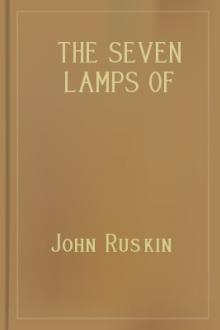The Seven Lamps of Architecture, John Ruskin [room on the broom read aloud .txt] 📗

- Author: John Ruskin
- Performer: -
Book online «The Seven Lamps of Architecture, John Ruskin [room on the broom read aloud .txt] 📗». Author John Ruskin
XIII. It is to be remembered, however, that while the ornaments in every fine ancient building, without exception so far as I am aware, are most delicate at the base, they are often in greater effective quantity on the upper parts. In high towers this is perfectly natural and right, the solidity of the foundation being as necessary as the division and penetration of the superstructure; hence the lighter work and richly pierced crowns of late Gothic towers. The campanile of Giotto at Florence, already alluded to, is an exquisite instance of the union of the two principles, delicate bas-reliefs adorning its massy foundation, while the open tracery of the upper windows attracts the eye by its slender intricacy, and a rich cornice crowns the whole. In such truly fine cases of this disposition the upper work is effective by its quantity and intricacy only, as the lower portions by delicacy; so also in the Tour de Beurre at Rouen, where, however, the detail is massy throughout, subdividing into rich meshes as it ascends. In the bodies of buildings the principle is less safe, but its discussion is not connected with our present subject.
XIV. Finally, work may be wasted by being too good for its material, or too fine to bear exposure; and this, generally a characteristic of late, especially of renaissance, work, is perhaps the worst fault of all. I do not know anything more painful or pitiful than the kind of ivory carving with which the Certosa of Pavia, and part of the Colleone sepulchral chapel at Bergamo, and other such buildings, are incrusted, of which it is not possible so much as to think without exhaustion; and a heavy sense of the misery it would be, to be forced to look at it at all. And this is not from the quantity of it, nor because it is bad work—much of it is inventive and able; but because it looks as if it were only fit to be put in inlaid cabinets and velveted caskets, and as if it could not bear one drifting shower or gnawing frost. We are afraid for it, anxious about it, and tormented by it; and we feel that a massy shaft and a bold shadow would be worth it all. Nevertheless, even in cases like these, much depends on the accomplishment of the great ends of decoration. If the ornament does its duty—if it is ornament, and its points of shade and light tell in the general effect, we shall not be offended by finding that the sculptor in his fulness of fancy has chosen to give much more than these mere points of light, and has composed them of groups of figures. But if the ornament does not answer its purpose, if it have no distant, no truly decorative power; if generally seen it be a mere incrustation and meaningless roughness, we shall only be chagrined by finding when we look close, that the incrustation has cost years of labor and has millions of figures and histories in it and would be the better of being seen through a Stanhope lens. Hence the greatness of the northern Gothic as contrasted with the latest Italian. It reaches nearly the same extreme of detail; but it never loses sight of its architectural purpose, never fails in its decorative power; not a leaflet in it but speaks, and speaks far off, too; and so long as this be the case, there is no limit to the luxuriance in which such work may legitimately and nobly be bestowed.
Ornaments from Rouen, St. Lo, and Venice.
XV. No limit: it is one of the affectations of architects to speak of overcharged ornament. Ornament cannot be overcharged if it be good, and is always overcharged when it is bad. I have given, on the opposite page (fig. 1), one of the smallest niches of the central gate of Rouen. That gate I suppose to be the most exquisite piece of pure flamboyant work existing; for though I have spoken of the upper portions, especially the receding window, as degenerate, the gate itself is of a purer period, and has hardly any renaissance taint. There are four strings of these niches (each with two figures beneath it) round the porch, from the ground to the top of the arch, with three intermediate rows of larger niches, far more elaborate; besides the six principal canopies of each outer pier. The total number of the subordinate niches alone, each worked like that in the plate, and each with a different pattern of traceries in each compartment, is one hundred and seventy-six.4 Yet in all this ornament there is not one cusp, one finial that is useless—not a stroke of the chisel is in vain; the grace and luxuriance of it all are visible—sensible rather—even to the uninquiring eye; and all its minuteness does not diminish the majesty, while it increases the mystery, of the noble and unbroken vault. It is not less the boast of some styles that they can bear ornament, than of others that they can do without it; but we do not often enough reflect that those very styles, of so haughty simplicity, owe part of their pleasurableness to contrast, and would be wearisome if universal. They are but the rests and monotones of the art; it is to its far happier, far higher, exaltation that we owe those fair fronts of variegated mosaic, charged with wild fancies and dark hosts of imagery, thicker and quainter than ever filled the depth of midsummer dream; those vaulted gates, trellised with close leaves; those window-labyrinths of twisted tracery and starry light; those misty masses of multitudinous pinnacle and diademed tower; the only witnesses, perhaps that remain to us of the faith and fear of nations. All else for which the builders sacrificed, has passed away—all their living interests, and aims, and achievements. We know not for what they labored, and we see no evidence of their reward. Victory, wealth, authority, happiness—all have departed, though bought by many a bitter sacrifice. But of them, and their life, and their toil upon the earth, one reward, one evidence, is left to us in those gray heaps of deep-wrought stone. They have taken with them to the grave their powers, their honors, and their errors; but they have left us their adoration.
CHAPTER II. THE LAMP OF TRUTH.I. There is a marked likeness between the virtues of man and the enlightenment of the globe he inhabits—the same diminishing gradation in vigor up to the limits of their domains, the same essential separation from their contraries—the same twilight at the meeting of the two: a something wider belt than the line where the world rolls into night, that strange twilight of the virtues; that dusky debateable land, wherein zeal becomes impatience, and temperance becomes severity, and justice becomes cruelty, and faith superstition, and each and all vanish into gloom.
Nevertheless, with the greater number of them, though their dimness increases gradually, we may mark the moment of their sunset; and, happily, may turn the shadow back by the way by which it had gone down: but for one, the line of the horizon is irregular and undefined; and this, too, the very equator and girdle of them all—Truth; that only one of which there are no degrees, but breaks and rents continually; that pillar of the earth, yet a cloudy pillar; that golden and narrow line, which the very powers and virtues that lean upon it bend, which policy and prudence conceal, which kindness and courtesy modify, which courage overshadows with his shield, imagination covers with her wings, and charity dims with her tears. How difficult must the maintenance of that authority be, which, while it has to restrain the hostility of all the worst principles of man, has also to restrain the disorders of his best—which is continually assaulted by the one, and betrayed by the other, and which regards with the same severity the lightest and the boldest violations of its law! There are some faults slight in the sight of love, some errors slight in the estimate of wisdom; but truth forgives no insult, and endures no stain.
We do not enough consider this; nor enough dread the slight and continual occasions of offence against her. We are too much in the habit of looking at falsehood in its darkest associations, and through the color of its worst purposes. That indignation which we profess to feel at deceit absolute, is indeed only at deceit malicious. We resent calumny, hypocrisy and treachery, because they harm us, not because they are untrue. Take the detraction and the mischief from the untruth, and we are little offended by it; turn it into praise, and we may be pleased with it. And yet it is not calumny nor treachery that does the largest sum of mischief in the world; they are continually crushed, and are felt only in being conquered. But it is the glistening and softly spoken lie; the amiable fallacy; the patriotic lie of the historian, the provident lie of the politician, the zealous lie of the partizan, the merciful lie of the friend, and the careless lie of each man to himself, that cast that black mystery over humanity, through which any man who pierces, we thank as we would thank one who dug a well in a desert; happy in that the thirst





Comments (0)